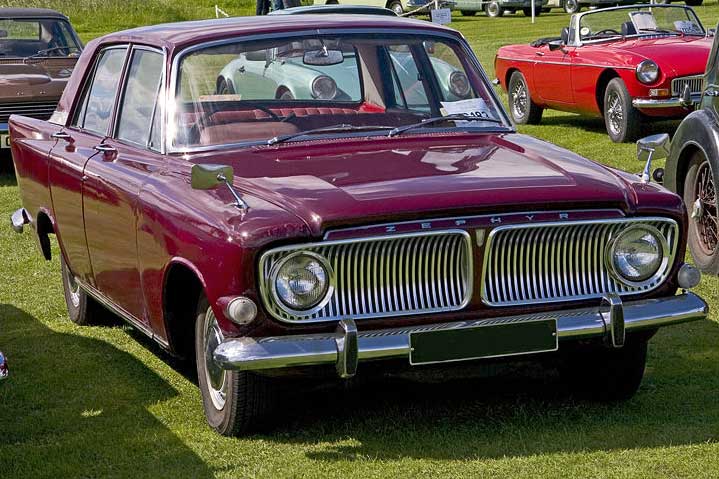Ford Zephyr/Zodiac MK III
Andrew Roberts recalls the arresting tail-finned Ford of 1962 that put the 'Z' into 'Z-Cars'

In early 1962, the British motorist with a limited budget and a need to reinforce his reputation as a "legitimate businessman", often sought the magic formula of six seats, six cylinders, a large boot and a degree of transatlantic glamour. And for that there was only one real contender: the new Ford Zephyr 6 Mk III, a car so advanced it had two-speed wipers, but not so American in appearance that it made the owner look like a spiv. Perish the thought.
Essentially, the Zephyr/ Zodiac Mk III range built on the strengths of the previous big British Fords. The Zephyr 6 featured the same 2553cc engine as its 1956-1962 predecessor, but the higher compression ratio gave an extra 20bhp, and the chassis design was also based on that of the Mk II but with stronger construction. The Mk II's unreliable and imprecise three-speed gearbox had finally been replaced by an all-synchromesh four-on-the-column, the rear axle was strengthened, and the entire pre-production testing process was unique for a British car at that time.
But above all it was the styling that was responsible for luring motorists into their local Ford dealer. Inspired by a proposal from the Italian design house Fura, Roy Brown produced a dashing saloon, one that spoke of an affluent future where everyone would own a car with a strip speedometer and canted tail fins. A few wondered how, in a vehicle over 15ft long, with a vast boot, there was room for passengers. In fact, the Zephyr Mk III had the width to accommodate six, but legroom was sacrificed.
Ford was now applying the Consul badge as a suffix to its medium-sized models – the Classic, Cortina and Corsair – and the entry-level Mk III was now badged as the Zephyr 4. It was also fitted with the same 1703cc engine as the Mk II Consul, which, owing to the Mk III's heavier body, gave even more abysmal acceleration and top speed than its predecessor, but the Zephyr 4 enjoyed a following with taxi firms and the armed forces. The mid- range offering was the 2.5 litre Zephyr 6, with its split radiator grille incorporating the headlamps, and the ultimate British Ford was the Zodiac, which boasted quad headlamps, six-window styling, and a slightly up-rated engine to give genuine 100mph performance.
Of course, neither the Zephyr 4 nor 6 could be described as luxurious – to keep the price down, a heater and windscreen washers stayed on the extras list – but at least the Mk II's vacuum wipers had been replaced by a two-speed electric motor, and an attempt by Ford's US parent to fit the Mk III with drum brakes was foiled when a prototype proved to be almost literally unstoppable.
As befitting its slightly higher price, the Zephyr 6 was equipped with front folding armrest, invaluable for keeping the driver anchored, and offered smoothness and performance at a price still well below £1,000. As a six-cylinder fleet car, the 2.5 litre Zephyr had obvious appeal and, as Ford was keen to build on the constabulary success of previous Zephyrs, the Mk III was inevitably offered as a "police special".
British films of the early 1960s often give the impression that all British police cars then were either Humbers or Wolseleys, but the big Ford was the car of choice for many a provincial force. Large enough for general patrol duties but not too bulky for urban work, and with an excellent aftercare service provided by Dagenham, the Zephyr 6 Police Special featured the Zodiac's higher- tuned engine, extra wiring looms for the necessary equipment, heavy-duty suspension, a modified dashboard to accommodate the recalibrated speedometer, and, for ease of operation, a floor-mounted gear lever with closer ratios than the standard column shift.
A handful of Zephyr 6 Estates, with coach built by Abbots of Farnham, were used for motorway duties, where their acceleration proved more than adequate, even in the pre-speed-limit era. One problem, however, was that the Zephyr 6 was prone to swerving while in high-speed pursuit because of its weight distribution, but an enterprising police driver in Devon devised a "technical modification": a concrete kerbstone placed in the boot.
Of all of the UK's forces, it was Lancashire that was the most associated with the Zephyr Mk III. It was one of the comparatively few constabularies to use the under-powered Zephyr 4 – indeed, when Unit Beat cars were launched in 1965, Lancashire repainted some of its black CID Zephyr 4s in the two-tone "Panda" finish – but it was thanks to BBC TV that the Zephyr 6 Mk III became indelibly associated with North Country policing. Ironically, although the cars used in the original 1962 series of Z-Cars were authentic Lancashire-police Zephyr Mk IIs, a falling out between the BBC and the chief constable (Policemen hitting their wives, and with awful table manners? Never!), meant that the 1963-1965 seasons used Ford PR Fleet Mk III Zephyr 6s.
The Mk III's lifespan was always going to be limited since, as early as 1963, Ford was planning the Mk IV. But the Mk III Zephyr 6 still brings backimages of Brian Blessed or Colin Welland spinning its vast Bakelite wheel and shouting: "BD to Z-Victor 1!"
Subscribe to Independent Premium to bookmark this article
Want to bookmark your favourite articles and stories to read or reference later? Start your Independent Premium subscription today.

Join our commenting forum
Join thought-provoking conversations, follow other Independent readers and see their replies